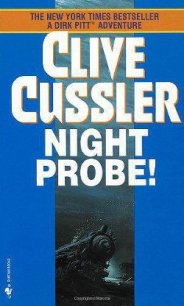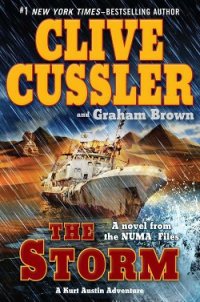The Mayan Secrets - Cussler Clive (читать бесплатно полные книги TXT) 📗
“I know,” Sam said. “Maybe there’s something else up there — good fields or something.”
“I’d hate to carry the harvest down this path,” Remi said.
“Then what do you think it could be?”
“I’m hoping it’s a shortcut to another village that has an air-conditioned spa and restaurant.”
“A good working theory,” he said. “I’ll accept it until we find something better. That’s the way we scientists operate.”
In ten more minutes, they reached the head of the path. They climbed up onto the level top of the plateau and looked around. There were several large mounds of earth that might be buildings, but they were not on the scale of the buildings in the cities they had found. They weren’t high or steep, and the plateau wasn’t large enough for monumental architecture. It was only about three hundred feet across.
They both noticed something else. The perimeter of the plateau had a low ridge around it like the rim of a bowl. They walked along the ridge, taking pictures, and then Sam stopped at a section that had fallen down. It revealed the ridge to actually be a pile of stones and earth.
“It’s a wall. It’s like the old Roman forts you find in Europe — low walls of stone piled up to stop an enemy attack. This was built for a battle.”
“It’s not like any of the other ruins we visited,” Remi said. “It feels different — not empty, somehow.”
They walked the rest of the way around the plateau. In the middle of the flat space, there were more low mounds of earth and stone, all of them overgrown with small plants. The only sounds on the plateau were the movements of the leaves in a soft wind and the calls of birds. At times, it was so quiet that Sam’s and Remi’s footsteps were the loudest sounds.
Remi said, “This isn’t a place where people would live. It reminds me of the cenote a few miles from here. The wall around it seemed to be made for a last stand too.”
“I know what you mean,” said Sam. “This and the cenote must be relics of a war between cities.”
They came across a trench about three feet deep and only wide enough for a man to stand in it and dig. It ran from the stone wall at the rim of the plateau for about a hundred feet and directly into one of the mounds. “Uh-oh,” said Remi.
“Do you know what that is?”
“I think it’s the kind of trench that pot hunters and grave robbers dig to find underground chambers and caches.”
Sam raised his satellite phone and took a few pictures of it, then sent them to Selma. He and Remi walked along the trench, looking into it. “If that’s what it was, it seems to have failed. It doesn’t lead to a bigger hole, where they might have found something and dug it up.”
The trench stopped at the base of the mound. When they reached the spot, Remi said, “It doesn’t seem to have stopped here. The rocks that are piled on the side of the mound are different. I think somebody dug into the mound and then covered the hole after they were done.”
“It’s puzzling,” said Sam.
“The word is ‘creepy,’” Remi said.
“Creepy, then.” He bent and began to lift the stones that had been placed in the opening and toss them to one side.
“You’re going to dig into it? That’s not why we came here. We were just locating sites, photographing them, and describing what’s in them so David Caine can register them.”
“I can’t very well describe what’s here unless I know,” said Sam. “This could be anything.”
“It could be a tomb. Judging from the trench, that’s what whoever beat us here thought.”
“Or it could be a pile of the right-sized rocks for throwing down at invaders. Or a big pile of potsherds, which, as you know, is the most common find at any archaeological site.”
Remi sighed, knelt beside Sam, and began lifting stones from the mound and tossing them aside. They worked until the stones revealed the straight, even sides of an entrance. “A doorway,” she said. “So much for the rock-pile theory and the broken-pot theory.”
“Still have a bad feeling?”
“More and more,” said Remi. “I’m just going along with this to show you what a great sport I am.”
“We’re almost in,” Sam said.
Remi stepped back from the opening and let Sam haul the last few rocks away. Then he said, “We’re in.” He stood, took the flashlight from his pack, aimed it into the opening, and crawled inside.
There was silence. Remi sat still for a minute, listening. Finally, her curiosity overpowered her caution. She took her own flashlight out and entered.
As soon as she was inside, she realized that the space was large and hollow. Her flashlight beam caught white stucco walls covered with realistic murals of old Mayans. There were many glyphs, and between them were pictures of dozens of men in feathered headdresses and wearing jaguar skins. Some carried short spears, round shields, clubs with sharp obsidian teeth. They were going into battle.
When her flashlight reached the floor, Remi jumped and gave a small cry. Lying on the other side of the chamber was a corpse. The body was in a state similar to the mummified man she and Sam had found on Volcan Tacana in Mexico. His skin was brown and leathery, his body skeletal. He was lying near a second doorway. There were strips of cloth, a tanned belt, and boots on him, and beside him was a broad-brimmed felt hat.
Sam appeared in the second doorway. “I’m sorry, I should have warned you.”
“Every day is Halloween lately,” she said. She knelt by the dead man and gave him a closer look. “What do you suppose got him — a jaguar? His clothes are torn, and he has big wounds.”
“Take a look at his revolver.”
Remi saw the old-fashioned, long-barreled revolver by his right hand. She bent low to look into the front of the cylinder and then rotated it. “He fired all six.”
“Right. And I don’t see any jaguar bones.”
“Do you recognize the gun?”
“It looks like a Colt Single Action Army, which would date it — and him — at 1873 or later.”
She said, “His skull is crushed on the left side.”
“That was one of the details I was going to mention after we were outside in the daylight.”
“This man was clubbed to death,” she said. “He was murdered.” She got up, and they both walked into the inner chamber. Inside was a low bier made of cut stone. On it lay a skeleton adorned with a gold breastplate, a strip of gold with carved jade stones for a headpiece, jade ear plugs. There was an obsidian knife, a club, and a large number of carved-jade and beaten-gold objects.
“The tomb is intact,” said Remi. “How can it possibly be intact? Whoever killed that guy out there must have known there was gold in here.”
Sam and Remi both heard a shuffling sound and then another. They stepped to the doorway. Gathered in the outer chamber were a half dozen people from the nearby town — Senora Velasquez; Pepe, the mechanic; Senor Alvarez, the restaurant owner, his son, and two others they didn’t know. Three of them were holding guns of some description, the others knives, and all of them looked furious.
Sam said, “Hello, ladies and gentlemen.”
Senora Velasquez said, “Come out of there very slowly and carefully.”
“We meant no harm,” Remi said. “We just saw that—”
“Quiet or you’ll be as dead as he is.”
Sam and Remi walked past the armed townspeople into the sunlight. Waiting in a large circle around them were about fifty other residents of Santa Maria de los Montanas. Some of them held machetes, others axes or hatchets. There were a couple of baseball bats. A few people held hunting rifles or shotguns, and there were pistols nearly as old as the one beside the man in the tomb.
The menace was palpable. The rifles and shotguns were aimed at Sam and Remi. There were two men with ropes, which seemed even more ominous than the weapons.
A man they had not seen before stepped out of the crowd. He had the sun-darkened face and sinewy arms of a farmer. He looked at Sam and Remi with eyes as hard as obsidian. “I’ll volunteer to dig graves. We can throw the bodies down from here and bury them where they fall. Who will help me?”



